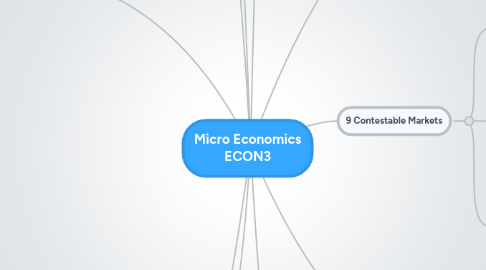
1. 2 Profit Maximisation
1.1. MC = MR
1.2. Definitions
1.2.1. Normal Profit
1.2.1.1. The level of profit which is just enough to keep all factors of production in their current use
1.2.2. Supernormal profit
1.2.2.1. Anything above normal profit
1.3. Role of profit
1.3.1. Signaling
1.3.2. Promotes inovation
1.3.3. Allocation of factors of production
1.4. Is profit really maximised?
1.4.1. Managerial theory
1.4.1.1. Revenue maximisation
1.4.1.2. Market share maximisation
1.4.1.3. Principle agent problem
1.4.1.3.1. Devision between owners and managers
1.4.2. Behavioural theroies
1.4.2.1. A firm is so complex that maximising a single variable is impossible
2. 3 Perfect Competition
2.1. What is it?/ What is needed for it?
2.1.1. Many buyers and sellers
2.1.2. No barriers to entry or exit
2.1.3. Identical products
2.1.4. Perfect information
2.1.5. No externalities
2.1.6. No economies of scale
2.2. Definitions
2.2.1. Sunk costs
2.2.1.1. A cost that cannot be recovered
2.2.2. The competitive process
2.2.2.1. Scarce resourses
2.2.2.2. Formation of prices/ supply and demand
2.2.2.3. Profits or losses emerge
2.2.2.4. Firms leave or enter the industry
2.2.3. The shutdown condition
2.2.3.1. Short run: Price < AVC
2.2.3.2. Long run: Price < AC
2.3. The real world
2.3.1. Firms compete on other areas
2.3.1.1. E.g. Brand
2.3.1.2. Quality
2.3.1.3. USP
3. 10 Technology and market structure
3.1. Production
3.1.1. Short term
3.1.1.1. Can increase startup costs and barriers to entry
3.1.1.1.1. Move towards capital intensive production causes job losses
3.1.2. Long term
3.1.2.1. Decreases average costs as more can be produced from the same inputs
3.2. Consumption
3.2.1. Leads to fall in prices if the market is competitive
3.2.2. Leads to better quality
3.3. Efficiency
3.3.1. Technology improves both product and process efficiency.
3.4. Increase in competition or monopoly?
3.4.1. In this seance the effect on structure depends on the type of technological advancement and on the type of market
4. 7 Monopoly
4.1. Definitions
4.1.1. Monopoly
4.1.1.1. When one firm has over 80% of the market share
4.1.1.2. There are several different definitions as a monopoly is defined depending on its characteristics
4.2. Effects of monopoly
4.2.1. Consumer
4.2.1.1. High prices and reduction of consumer surplus
4.2.2. Producer
4.2.2.1. Long term supernormal profita
4.3. Efficiency
4.3.1. Dynamic
4.3.1.1. Can be dynamically efficient due to large capital available for investment
4.3.2. Static
4.3.2.1. Not allocatively efficient due to profit maximisation
4.3.2.2. Not productively efficient
5. 8 Oligopoly
5.1. Definitions
5.1.1. Oligopoly
5.1.1.1. When 5 or less firms have over 80% of market share.
5.1.2. Collusion
5.1.2.1. When firms in an oligopoly collectively decide to raise prices
5.1.3. Tacit collusion
5.1.3.1. Collusion with no direct communication
5.2. Effects
5.2.1. If collusive, an oligopoly can have the same effects as a monopoly
5.3. The magic number 5
5.3.1. Game theory suggests that collusion cannot hold with many more than 5 firms
5.3.2. This is because that with more firms the greater the chance that one will abandon the group and act under self interest by dropping prices
5.4. Kinked demand curve
5.4.1. Low quantities
5.4.1.1. Elastic as none follow a rise in price
5.4.2. High quantities
5.4.2.1. Inelastic as dropping price is followed by others so market share changes little
6. 4 Efficiency, Consumer & Producer Surplus
6.1. Definitions
6.1.1. Consumer surplus
6.1.1.1. The difference between the price the consumer is prepared to pay and the market price
6.1.2. Producer surplus
6.1.2.1. The difference between the price a producer is prepared to sell at and the market price
6.1.3. Static efficiency
6.1.3.1. Occurs at a given point in time
6.1.4. Dynamic efficiency
6.1.4.1. Occurs over time
6.2. Static efficiency
6.2.1. Allocative efficiency
6.2.1.1. When Price = Marginal cost
6.2.2. Productive efficiency
6.2.2.1. Producing at the lowest point on the AC curve
6.2.3. X efficiency
6.2.3.1. Organisational slack that occurs through lack of competition
6.3. Dynamic efficiency
6.3.1. Product efficiency
6.3.2. Process efficiency
7. 5 Concentrated Markets
7.1. Concentration ratio
7.1.1. value of output from the x largest firms/ value of output for the industry
7.2. Internal growth
7.2.1. When a company internally finances its own expansion through profits and re-investment
7.3. External growth
7.3.1. Horizontal
7.3.1.1. When a company takes over a rival that is in the same industry at the same point in the supply chain
7.3.2. Vertical up
7.3.2.1. Merger up the supply chain away from the consumer
7.3.3. Vertical down
7.3.3.1. Movement down the supply chain
7.3.4. Lateral
7.3.4.1. Take over of a company in a similar but different industry
7.3.5. Conglomerate merger
7.3.5.1. Take over of a total different company in a totally different industry
8. 6 Price Discrimination
8.1. What is needed for it to be possible?
8.1.1. Differences in PED
8.1.2. Barriers to prevent "market seepage"
8.2. First degree
8.2.1. Each consumer gets and individual price
8.3. Second degree
8.3.1. This is selling bulk orders at a lower per unit price
8.4. Third degree
8.4.1. This is the most common
8.4.1.1. Discriminating in terms of time or age etc...
9. 1 Costs & Revenues
9.1. Costs
9.1.1. Variable Costs
9.1.1.1. Costs that vary proportionately with quantity produced
9.1.2. Fixed Costs
9.1.2.1. Costs that do not vary with quantity produced
9.1.3. Total cost
9.1.3.1. Total cost of producing a given amount
9.1.4. Marginal cost
9.1.4.1. Cost of the next unit produced
9.1.5. Average cost
9.1.5.1. A total cost divided by the number of units produced
9.2. Revenues
9.3. Economies of scale
9.4. Law of Diminishing returns
10. 9 Contestable Markets
10.1. Definitions
10.1.1. Sunk Costs
10.1.1.1. Costs that cannot be recovered. A barrier to exit
10.1.2. Perfectly Contestable
10.1.2.1. A market with no costs to entry or exit
10.1.3. Hit and Run entry
10.1.3.1. When a new firm enters a contestable market as they believe there are profits to be made.
10.2. Effects
10.2.1. Risk of hit and run entry due to no barriers to entry
10.2.1.1. Competitive prices
10.2.1.2. No collusion or oligopolistic behaviour
10.3. What helps create contestablility?
10.3.1. New technology
10.3.2. Enterprise
10.3.3. Competition policy
10.3.4. De-regulation
10.3.5. Increased market size
